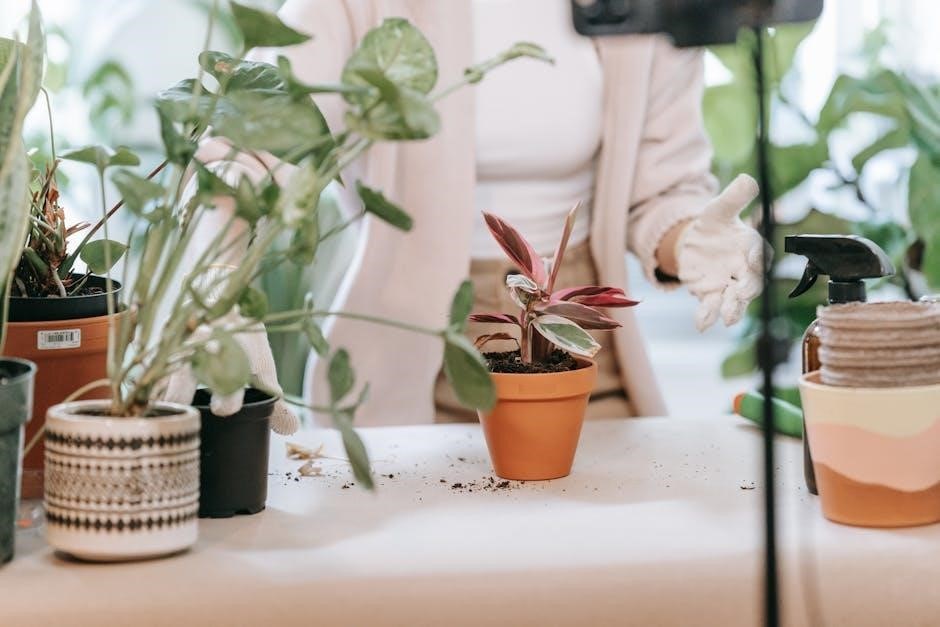USDA Hardiness Zone 10b is a warm climate region with mild winters and hot summers, ideal for year-round gardening. Minimal frost allows for diverse plant growth, making it perfect for gardeners seeking continuous harvests and vibrant landscapes.
1.1 Understanding USDA Hardiness Zones
The USDA Hardiness Zones are a guide to determine which plants can thrive in specific regions based on average annual extreme temperatures. Zone 10b, with mild winters (25-30°F) and hot summers, is ideal for plants that cannot tolerate frost. This system helps gardeners choose appropriate plants for their climate, ensuring better growth and survival. Zone 10b’s warm conditions allow for year-round gardening, making it a favored region for diverse plant cultivation. By understanding these zones, gardeners can make informed decisions about planting times and plant selection, maximizing their gardening success in Zone 10b’s unique climate.
1.2 Climate Characteristics of Zone 10b
Zone 10b is characterized by its warm, subtropical climate with mild winters and hot, humid summers. The average annual extreme minimum temperature ranges from 35°F to 40°F, with minimal frost occurrences. This USDA hardiness zone enjoys long growing seasons, allowing gardeners to cultivate a wide variety of plants year-round. The region experiences intense sunlight and high temperatures during summer months, necessitating careful watering and shading strategies. Winters are mild, making it ideal for cool-season crops. The climate’s warmth and minimal cold snaps create a unique environment where tropical and subtropical plants thrive alongside traditional garden varieties. Understanding these characteristics is essential for selecting appropriate plants and implementing effective gardening practices tailored to Zone 10b’s conditions.

Best Plants for Zone 10b
Zone 10b supports a wide variety of plants, including warm-season vegetables, citrus trees, tropical flowers, and drought-tolerant ornamentals, making it ideal for diverse and vibrant gardens year-round.
2.1 Vegetables Suitable for Year-Round Growth
In Zone 10b, gardeners can grow a wide variety of vegetables year-round due to the warm climate. Leafy greens like kale, spinach, and lettuce thrive in cooler months, while heat-tolerant crops such as tomatoes, peppers, and eggplants excel in summer. Root vegetables like carrots, beets, and radishes can be planted in fall and winter. Herbs like basil, cilantro, and parsley also grow well. Succession planting and using shade cloth can help manage summer heat, ensuring continuous harvests. With proper planning, Zone 10b gardeners can enjoy fresh produce throughout the year.
2.2 Fruit Trees and Berries That Thrive in Zone 10b
Zone 10b’s warm climate is ideal for growing a variety of fruit trees and berries. Citrus trees like oranges, lemons, and limes excel in the region’s mild winters and hot summers. Avocado trees, particularly Hass and Fuerte varieties, thrive in Zone 10b, producing abundant fruit. Guava trees are another excellent choice, offering sweet fruit and adaptability to the climate. For berries, strawberries are a top pick, as they grow year-round in Zone 10b. Blueberries, especially dwarf varieties like ‘Tophat,’ also succeed with proper soil conditions. These plants benefit from full sun, well-drained soil, and consistent watering. They add fresh, nutritious produce to any garden, making Zone 10b a paradise for fruit enthusiasts.
2.3 Flowering Plants and Ornamentals
Zone 10b offers ideal conditions for a wide variety of flowering plants and ornamentals, which thrive in its warm, frost-free climate. Popular choices include Lantana, Bougainvillea, and Hibiscus, known for their vibrant blooms and drought tolerance. Geraniums and Marigolds add bright colors to gardens, while Succulents like Echeveria and Aloe Vera provide low-maintenance beauty. For fragrant options, Jasmine and Gardenias are excellent selections. These plants typically require full sun and well-drained soil to flourish. Planting in spring or fall is recommended to avoid extreme summer heat. With proper care, Zone 10b gardeners can enjoy a stunning display of flowers and ornamentals year-round, enhancing both beauty and biodiversity in their outdoor spaces.
2.4 Herbs and Microgreens for Continuous Harvest
Zone 10b’s warm climate is ideal for growing a variety of herbs and microgreens year-round. Popular herbs like basil, mint, parsley, cilantro, dill, rosemary, thyme, and oregano thrive in the region’s mild winters and hot summers. Microgreens such as arugula, kale, spinach, and lettuce can be harvested in as little as 1-3 weeks, providing fresh, nutrient-dense greens continuously. These plants prefer well-draining soil and partial shade to avoid overheating. Regular watering and fertilization every few weeks ensure healthy growth. Many herbs and microgreens can also be grown in containers, making them versatile for small or large gardens. With proper care, Zone 10b gardeners can enjoy fresh flavors and greens throughout the year, adding vibrancy and nutrition to their meals.

Monthly Planting Guide
Zone 10b offers year-round planting opportunities due to its mild climate. Here’s a breakdown of what to plant each month for optimal growth and bounty.
- Spring: Plant warm-season vegetables like tomatoes, peppers, and zucchini. Flowers such as marigolds and sunflowers thrive during this time.
- Summer: Focus on heat-tolerant crops like okra, eggplant, and herbs such as basil and mint. Regular watering is essential.
- Fall: Sow cool-season crops like broccoli, kale, and carrots. Plant bulbs for spring blooms and consider companion planting for pest control.
- Winter: Grow leafy greens, radishes, and citrus trees. Protect sensitive plants from rare frosts using mulch or covers.
3.1 Spring Planting Recommendations
Spring in Zone 10b is ideal for planting warm-season crops, as temperatures remain mild, ranging from 35°F to 50°F. Start by planting tomatoes, peppers, and eggplants, which thrive in the region’s climate. Direct sow seeds for zucchini, beans, and squash. Herbs like basil and cilantro also excel during this time. Consider starting seedlings indoors 4-6 weeks before the last frost date to give them a head start. Ensure soil is well-draining and enriched with organic matter. Water deeply but avoid overwatering. Most plants require full sun (6-8 hours of direct sunlight) for optimal growth. Incorporate companion planting, such as marigolds with tomatoes, to deter pests. Rotate crops from the previous season to maintain soil health and prevent disease buildup.
3.2 Summer Planting Tips
Zone 10b’s warm summers are ideal for growing heat-tolerant plants. Focus on vegetables like tomatoes, peppers, and eggplants, which thrive in high temperatures. Incorporate herbs such as basil and mint for fresh flavor. Use compost-rich soil to maintain fertility and mulch to retain moisture. Water deeply but infrequently to encourage deep root growth. Consider drip irrigation to conserve water. Fertilize with a balanced formula to support vigorous growth. Keep an eye out for pests like aphids and whiteflies, using natural predators or organic pesticides when necessary. Plant heat-loving flowers like lantana or zinnias for color. Shade cloth can protect sensitive plants from intense sun. Regular pruning promotes air circulation and prevents disease. These strategies ensure a bountiful and vibrant summer garden in Zone 10b.
3.3 Fall Planting Suggestions
Fall in Zone 10b offers mild temperatures, making it an ideal time to plant cool-season crops. Vegetables like broccoli, kale, spinach, and carrots thrive in the cooler weather. Root vegetables such as beets and radishes also excel. Fruiting plants like strawberries and blueberries can be planted now for a winter harvest. Herbs like parsley, cilantro, and dill grow well in fall. Consider planting flowers like pansies or violas for vibrant color. Ensure soil is well-prepared, and water consistently but avoid overwatering. Mulching can help retain moisture and regulate soil temperature. Fall planting in Zone 10b allows for a bountiful winter harvest and sets the stage for a productive growing season ahead.
3.4 Winter Planting Options
Zone 10b’s mild winters offer a unique opportunity for year-round gardening. Cool-season crops like broccoli, kale, spinach, and carrots thrive during this time. Root vegetables such as beets and radishes also excel. Flowering plants like pansies, violas, and snapdragons add color to winter landscapes. Herbs like parsley, cilantro, and dill can be planted for fresh harvests. Bare-root fruit trees, such as citrus or berries, can be planted in late winter for spring growth. Winter is also ideal for planting bulbs like garlic and onions. Ensure plants are protected from occasional frost and maintain consistent watering. This season allows gardeners to enjoy a diverse and productive harvest, leveraging the region’s warm climate during cooler months.

Gardening Techniques for Zone 10b
Mastering gardening in Zone 10b requires adapting to its warm climate. Techniques include efficient watering, soil enrichment, and pest management to ensure thriving plants year-round.
4.1 Soil Preparation and Management
Preparing and managing soil in Zone 10b is crucial for optimal plant growth. The region’s warm climate means soil can dry out quickly, so improving water retention is essential. Start by testing your soil pH, as most plants thrive in a slightly acidic to neutral range (6.0–7.5). Incorporate organic matter like compost or well-rotted manure to enhance soil structure and fertility. Mulching helps retain moisture and suppress weeds, while avoiding over-tilling prevents soil compaction. Additionally, use cover crops during off-planting seasons to enrich the soil and reduce erosion. Regularly replenishing nutrients through balanced fertilizers ensures long-term soil health. Avoid over-fertilizing, as Zone 10b’s warm conditions can accelerate nutrient depletion. Proper soil management creates a resilient foundation for year-round gardening success in this zone.
4.2 Watering Strategies for Warm Climates
Efficient watering is crucial in Zone 10b’s warm climate to prevent water waste and root rot. Use drip irrigation or soaker hoses to deliver water directly to roots, reducing evaporation. Water deeply but infrequently to encourage deep root growth. Mulch around plants to retain soil moisture and regulate temperature. Avoid overhead watering, which can lead to fungal diseases; Instead, water in the early morning or evening to minimize evaporation. Check soil moisture by inserting a finger or trowel before watering. For containers, ensure good drainage and monitor soil dryness. Consider rainwater harvesting to supplement irrigation needs. Adjust watering schedules seasonally, as plants require more water during summer heat and less in cooler months. Proper watering techniques ensure healthy plant growth and resilience in Zone 10b’s challenging climate.
4.3 Fertilization and Nutrient Management
Fertilization is crucial for thriving plants in Zone 10b’s warm climate. Use balanced fertilizers (e.g., 10-10-10) during planting and monthly for vegetables and flowers. Organic options like compost tea or worm castings enhance soil health. For fruit trees, apply high-phosphorus fertilizers (e.g., 10-20-10) during flowering and fruiting. Avoid over-fertilizing to prevent root burn. Test soil pH regularly, as most plants prefer a range of 6.0–7.0. Incorporate mulch and cover crops to replenish nutrients naturally. Rotate crops to maintain soil fertility and reduce pest issues. Proper nutrient management ensures robust growth and maximizes yields in Zone 10b’s year-round gardening environment.
4.4 Pest and Disease Control
In Zone 10b, pests like aphids, whiteflies, and snails thrive in the warm climate. Regularly inspect plants and use organic controls such as neem oil or insecticidal soap. Encourage beneficial insects like ladybugs and lacewings to balance ecosystems. Diseases like powdery mildew and root rot can spread due to high humidity and improper watering. Ensure good air circulation, avoid overhead irrigation, and treat infections promptly with fungicides. Practice crop rotation to break disease cycles and maintain soil health. Keep tools clean to prevent spreading pathogens. Monitor for signs of stress, as it attracts pests. Use physical barriers for slugs and snails. Integrated pest management (IPM) strategies are essential for sustainable gardening in this zone.

Additional Resources and Tools
Explore online planting calendars, local nurseries, and gardening communities for Zone 10b. Check out books like Brad Lancaster’s “Rainwater Harvesting” for sustainable gardening tips and techniques.
5.1 Online Gardening Calendars for Zone 10b
Online gardening calendars tailored for Zone 10b provide detailed monthly planting schedules, ensuring optimal growth and productivity. These tools outline specific tasks such as seed sowing, pruning, and fertilizing, adapting to the region’s warm climate. Popular platforms like Sow True Seed offer customizable calendars, while apps and websites like Garden Plan Pro and Seed Savers Exchange provide interactive guides. These resources help gardeners track seasonal changes and plan accordingly, maximizing yields and reducing pests. By following these calendars, gardeners in Zone 10b can efficiently manage their gardens year-round, leveraging the region’s mild winters and hot summers for continuous growth.
5.2 Local Nurseries and Gardening Communities
Local nurseries in Zone 10b are invaluable resources for gardeners, offering plants tailored to the region’s climate. These nurseries often provide expert advice and region-specific products. Additionally, gardening communities, such as local gardening clubs or online forums like Reddit’s r/vegetablegardening, connect gardeners, fostering knowledge sharing and collaboration. Many communities organize workshops, plant swaps, and events to support growers. Online platforms like r/Permaculture also offer insights and advice specific to Zone 10b, emphasizing sustainable practices. Visiting local nurseries and engaging with these communities can enhance your gardening success and help you discover new techniques and plant varieties suited to your area.

5.3 Recommended Gardening Books and Guides
For Zone 10b gardeners, several books and guides provide tailored advice. Brad Lancaster’s Rainwater Harvesting for Drylands and Beyond is a must-read for water management. The New Seed Starter’s Handbook by Nancy Bubel offers insights into starting plants indoors. Carly Mejeur’s guide on organic gardening in Zone 10b highlights sustainable practices and pest management. Local nurseries often recommend The Vegetable Gardener’s Bible for crop-specific tips. Online resources like Sow True Seed’s planting calendar and Reddit forums (r/vegetablegardening, r/Permaculture) share community wisdom. These resources empower gardeners to maximize their yield and adapt to Zone 10b’s unique conditions, ensuring success in both edible and ornamental gardening endeavors.
